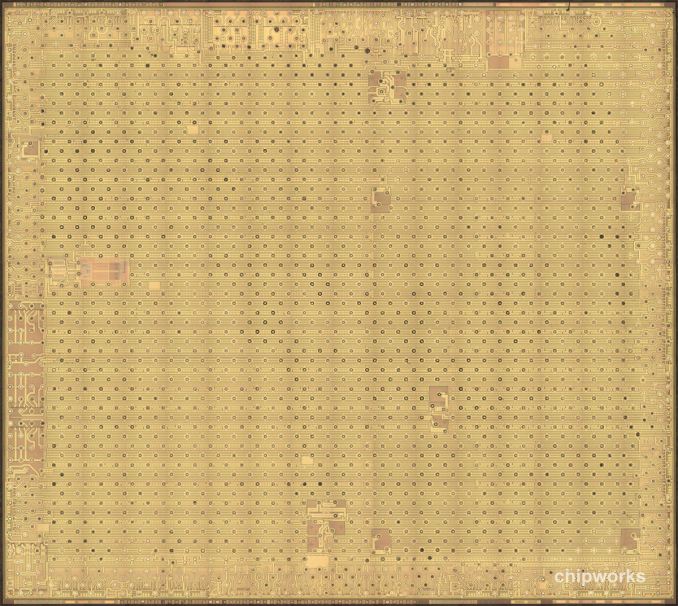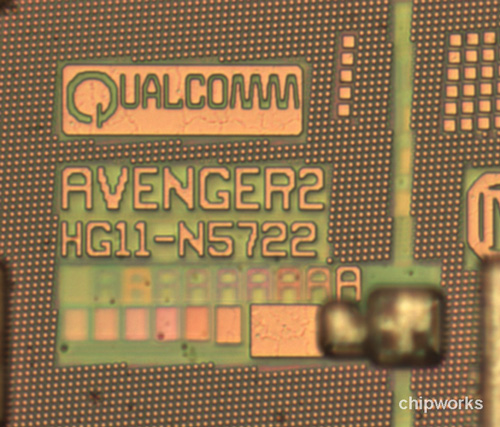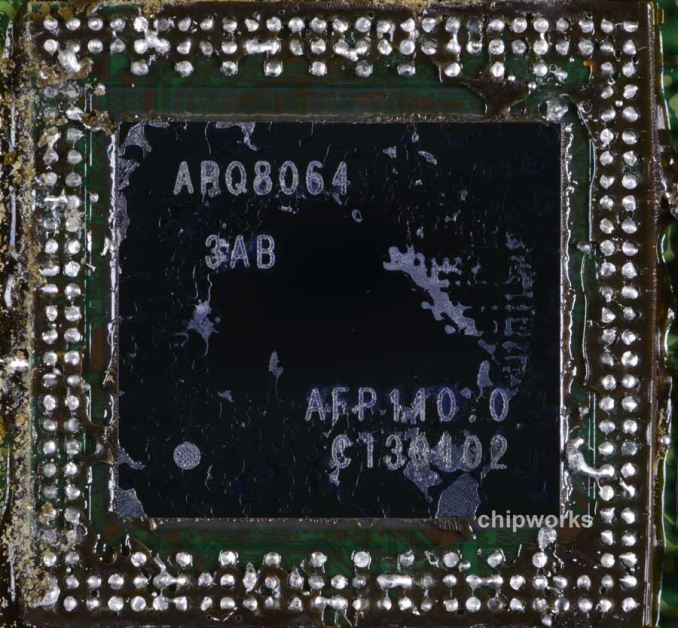Samsung Galaxy S 4 Review - Part 1
by Brian Klug on April 24, 2013 12:01 AM ESTGalaxy S 4 - Powered by a Better Snapdragon 600 (APQ8064AB)?
At a high level, Samsung's Galaxy S 4 integrates Qualcomm's Snapdragon 600 SoC. From what Qualcomm told us about Snapdragon 600, we're dealing with four Krait 300 cores and an Adreno 320 GPU. The Krait 300 cores themselves are supposed to improve performance per clock over the original Krait CPU (Krait 200) through a handful of low level microarchitectural tweaks that we've gone through here. The Krait 300 design also allegedly improves the ability to run at higher frequencies without resorting to higher voltages. This isn't the first time we've talked about Snapdragon 600, but since then a few things have come to light.

Snapdragon 600 from HTC One - Chipworks
For starters, Chipworks got their hands on a Snapdragon 600 SoC (from an HTC One) and delayered the SoC. In its investigation, Chipworks discovered that Snapdragon 600 had the exact same die area as the previous generation Snapdragon S4 Pro (APQ8064). Also, although you'd expect APQ8064T markings on the chip itself, the part carried the same APQ8064 label as previous S4 Pro designs.

Avenger 2 Markings on Snapdragon 600 die from HTC One - Chipworks
Chipworks did note however that there were some subtle differences between a standard APQ8064 and the Snapdragon 600 SoC from the HTC One. The Snapdragon 600 from the One is labeled with an Avenger2 codename rather than Avenger, the latter was apparently present on prior APQ8064 designs. Chipworks also noticed differences in the topmost metal layer, although it's not clear whether or not they stopped there or found no differences in lower layers.
All of this points to a much more subtle set of physical differences between APQ8064 and the earliest Snapdragon 600s. Metal layer changes are often used to fix bugs in silicon without requiring a complete respin which can be costly and create additional delays. It's entirely possible that Krait 300 was actually just a bug fixed Krait 200, which would explain the identical die size and slight differences elsewhere.
That brings us to the Galaxy S 4. It's immediately apparent that something is different here because Samsung is shipping the Snapdragon 600 at a higher frequency than any other OEM. The Krait 300 cores in SGS4 can run at up to 1.9GHz vs. 1.7GHz for everyone else. Curiously enough, 1.9GHz is the max frequency that Qualcomm mentioned when it first announced Snapdragon 600.
Samsung is obviously a very large customer, so at first glance we assumed it could simply demand a better bin of Snapdragon 600 than its lower volume competitors. Looking a bit deeper however, we see that the Galaxy S 4 uses something different entirely.
APQ8064 from a Snapdragon 600 based HTC One - Chipworks
Digging through the Galaxy S 4 kernel source we see references to an APQ8064AB part. As a recap, APQ8064 was the first quad-core Krait 200 SoC with no integrated modem, more commonly referred to as Snapdragon S4 Pro. APQ8064T was supposed to be its higher clocked/Krait 300 based successor that ended up with the marketing name Snapdragon 600. APQ8064AB however is, at this point, unique to the Galaxy S 4 but still carries the Snapdragon 600 marketing name.
If we had to guess, we might be looking at an actual respin of the APQ8064 silicon in APQ8064AB. Assuming Qualcomm isn't playing any funny games here, APQ8064AB may simply be a respin capable of hitting higher frequencies. We'll have to keep a close eye on this going forward, but it's clear to me that the Galaxy S 4 is shipping with something different than everyone else who has a Snapdragon 600 at this point.











335 Comments
View All Comments
Exodite - Wednesday, April 24, 2013 - link
The screen I'd imagine.The iPhone 5 has a screen that's ~65% the size, and ~35% of the resolution, of the one used by the Galaxy S4.
Its not the only reason of course but the screen matters a lot.
gnx - Wednesday, April 24, 2013 - link
Also a weakness of AMOLED. Since it needs to lighten up all subpixels max to get to white (and turns off all subpixels for gorgeous black). So web browsing, with so most sites having white background, really cranks up the power consumption of the display, hence the unexpectedly shorter battery life compared to other scenarios.sigmatau - Thursday, April 25, 2013 - link
I have a Nokia 900 with a Samsung sourced AMOLED plus which is beyond terrible outside on full brightness. I wonder how this one compares.lopri - Wednesday, April 24, 2013 - link
In that chart, iPhone 4S is leading Nexus 4. I have both and I call that bogus. Not sure what kind of iPhone 4S they've got.kmmatney - Wednesday, April 24, 2013 - link
We have mostly iPhones at my work, but a few SG3s. It's pretty easy to compare the real-use battery life at a conference, where we have to be on battery all day, and use are phones for normal stuff like email, texts, some web browsing, etc.. Without fail, the iPhones are all still going strong at the end of the day, while the SG3s have dead batteries. I was hoping the SGS4 would fix this, but I can't tell from the review. I hope the Note 3 increases the battery life.RealityMonster - Monday, April 29, 2013 - link
Apple has consistently refused to put tech in their phones unless they can still get 10hrs of battery life out of it. That's why the iPhone 5 is the first one to have LTE--the 4s just couldn't keep a charge long enough. Part of it is the form-factor, since a smaller phone means a smaller battery. Like other people have mentioned, though, the smaller screen is also a smaller power draw.So while you're never likely to see an iPhone that has a substantially better battery life than 10hrs under browsing conditions, you'll never see one that has a substantially lower life, either.
Gorgenapper - Tuesday, May 14, 2013 - link
That's a nice thing about Apple, they have a MUCH tighter control on their design and execution than Samsung ever could. People love to bash on Apple, and I admit that I'm not a big fan of many of Apple's decisions and products, but at least they know what they want to do, and go after it.Samsung, on the other hand, is more concerned with features, and less concerned with the quality of the execution of their overall product plan. I also get a vibe that Samsung caters more directly to the 'buy and throw away' mentality of most consumers, as OLEDs degrade at a faster rate than LCD (particularly blue subpixels), which was a reason why Samsung said that they used a pentile arrangement on the S3.
As for me, personally, I think I'll wait to see how the next gen iPhone looks like (rumored 4.5 ~ 4.8" screen), or more likely I'll wait to see how the next gen Nexus is. Assuming that I can't score a cheap 32gb Galaxy S4 after the big hype dies down.
mike55 - Wednesday, April 24, 2013 - link
I'm definitely torn between this and the HTC One. I'm also a bit disappointed that 32 GB of NAND isn't the standard minimum for flagship smartphones these days.Toss3 - Wednesday, April 24, 2013 - link
Both are great phones, but I'm buying the S4 because of the larger screen and smaller bezel. I also cannot stand the button layout of the HTC One. Was very surprised to see that the HTC One was very fluid, whereas the S4 stutters a bit. Especially considering the latter runs the SoC at a higher clockspeed. I also believe the camera of the S4 to be superior; even if the HTC One takes better night-shots, they're still not good enough for print or even watching on a 1080p TV(lots of noise and weird white-balance). The daylight shots from the S4 look pretty good, and are among the best of any phone right now.UpSpin - Wednesday, April 24, 2013 - link
4MP (2688x1520) translates to 22,76x12,87cm (8,96x5,067in) @ 300 DPI print resolution, I think that's enough. It's also above 1080p. People also forget that the HTC One contains a simple OIS!http://www.htc.com/www/zoe/stabilization/
But you're right, at best lightnig conditions, the S4 is superior, but I mostly never take pictures at best lightning conditions, but outside on a normal day, indoors poorly lit or indoors to scan documents.
According to other reviews the S4 stutters because of the gimmick features, once you turn off those advertised stuff, it should run better.